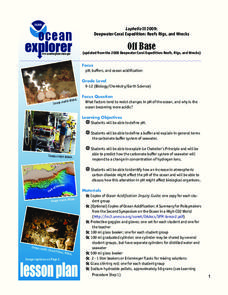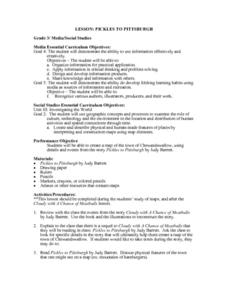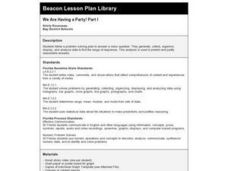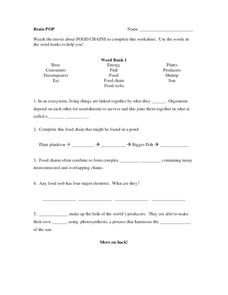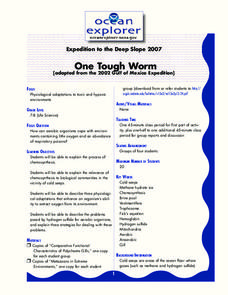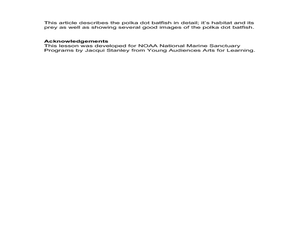Curated OER
Off Base
High schoolers explain the Chatelier's Principle. In this pH lesson, students identify factors that resist changes in pH of the ocean and why the ocean is becoming more acidic.
Curated OER
Ancient Bugs
High schoolers describe Archaea. In this biology lesson plan, students examine biological communities and the role Archaea plays. High schoolers will compare and contrast the Archaea with bacteria and eukaryote.
Curated OER
Famous Women in American History: Rose Freedman
Fourth graders read about Rose Freedman, a famous American woman. In this famous women in American history lesson, 4th graders read a story about Rose Freedman, answer comprehension questions, and complete an associated worksheet. They...
Curated OER
A Campfire Conversation
Students examine point of view as it relates to public issues. In this point of view lesson, students become familiar with the point of view of John Muir and Theodore Roosevelt about the wilderness. Students debate if the wilderness...
Curated OER
Covering the Campaign Trail: Technological Progress or Temporary Chaos?
Students study the changes in reporting and journalism techniques that have evolved due to advances in technology by reading an online transcript. They debate whether the technological advances are positive or negative in the reporting...
Curated OER
Patriots of the Revolution
Fifth graders identify causes and effects of historical events in the American Revolution. They evaluate critical issues and events that led to the American Revolution. Analyze the views and lives of people of the Revolutionary Period.
Curated OER
Pickles to Pittsburgh
Third graders explore the geography in the book "Pickles to Pittsburgh" by Judy Barrett. They read the story and identify the physical features of the town, discuss the elements included on a map, and create a map of the town of...
Curated OER
We Are Having a Party! Part I
Second graders use data analysis skills in order to plan a class party. They graph possible times for the party noting the range for times. They discuss how mathematicians find and use the range to analyze data.
Curated OER
Radio Program
High schoolers identify and assess the impact of unions on workers, management, and community. They listen to radio stories, students are asked what can they conclude about the impact of unions on the lives of the workers, management,...
Curated OER
Food Chains
In this chemistry worksheet, students watch a movie about food chains and use it to respond to each of the questions stated. They use the list of works in the word banks to assist them in matching the correct term to its description.
Curated OER
Living in Extreme Environments
High schoolers examine the characteristics of the ocean floor and the importance of of extreme environments. In this investigative instructional activity students use four methods to sample populations, gather, record and analyze data...
Curated OER
One Tough Worm
Learners explain the process of chemosynthesis and its relevance to biological communities. In this investigative lesson plan students discuss chemosynthetic communities, then in groups they are assigned a species and are to calculate...
Curated OER
Feeding in the Flow
Students examine current flow and describe ways in which it may effect food of reef building corals. In this coral lesson students identify two environmental factors that may affect the morphology.
Curated OER
Picture This!
Students compare and contrast different types of light on the electromagnetic spectrum. In this investigative lesson students create a photographic image that demonstrates the infrared, ultraviolet and polarization phenomena.
Curated OER
Pictograph Robe Stories
Fourth graders explore the diversity and commonality of human interdependence. Also, the global cooperation of the people of the United States and the world through a multicultural and historical perspective. They describe the...
Curated OER
Podcasting: Sharing Your Ideas About Featured Topics and Issues
Young scholars investigate podcasting. They read an article related to podcasting. Students access a podcast and using various features such as pausing, rewinding, and fast-forwarding. They work in small groups to produce an original...
Curated OER
American Dragon: Jake Long
Young scholars, after viewing the film "American Dragon," by Jake Long, explore and analyze the importance of legends and the unique cultures others grow up in. They stress the need for having a good self-esteem and assess how to work...
Curated OER
Pond Water Survey
In this pond ecosystem learning exercise, learners observe different species of plankton found in a pond water sample. They draw pictures of 5 specimens then describe them in detail.
Curated OER
Keep it Complex
Students consider the importance of biodiversity in the ocean layers. In this oceanography lesson, students use the Shannon-Weaver diversity index to analyze data. Students analyze the information collected and write a report offering...
Curated OER
Do You Have the Key?
Students practice using a dichotomous key. In this classification lesson, students read an article about scientific exploration and identification of new species. They use a dichotomous key to identify objects and create their own key.
Curated OER
Design a Reef!
Students design a functional model of a coral reef ecosystem. In this coral reef lesson, students identify the energy sources and material cycles of a coral reef. They write an essay about their niche in their own ecosystem.
Curated OER
Drawing Fish
Students practice creating art by imitating the camouflage of fish. In this animal characteristic lesson, students identify certain fish and their ability to change colors in order to survive in the wild. Students utilize coloring...
Curated OER
Group Foraging
Students explore co-operation by researching ocean life. In this fish science lesson, students identify many vocabulary terms associated with oceanography and discuss what group foraging means among fish. Students utilize paints and...
Curated OER
The Giant Barrel Sponge
Students study barrel sponges. In this science and art lesson, students discuss what sponges are, create their own sponge, and share what they created with the rest of the class.


